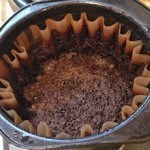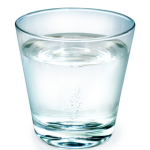Coffee Consumption Trends Worldwide In 2016
by Jeanette Kierstead
Coffee Consumption Trends Worldwide In 2016
U.S. COFFEE CONSUMPTION HAS DROPPED MORE THAN 50% IN 60 YEARS, YET COFFEE IS MORE POPULAR THAN EVER?
The USDA ERS (United States Department Of Agriculture Economic Research Service) reported in 2007 what many other graphs and charts have echoed to the point where it now seems like common knowledge: we as Americans don't drink as much coffee as we used to.
Contents
- Coffee In America
- Roughly 20 Gallons Of Coffee Annually Consumed Per Capita
- A Closer Look At The Downward Trend
- Popularity Of Coffee Versus Other Beverages
- Your Average Human Bladder
- Soda Pop, Energy Drinks, and Other Beverages
- Global Popularity Of Coffee In 2016
- Single-Serve "Revolution" Having Its Affect On Per Capita Coffee Intake
- We Waste Less Coffee Today Than We Did In The 1940's
- Increased Home Brewing Skills Leading To Less Waste?
- Coffee Trends In America & Around The World
- Related Posts
This trend seems in direct contrast to the idea that today coffee is now more popular than ever. On the graph below, the stats show that we were at our coffee-drinking peak back in 1946 with a national consumption of 46.4 gallons of coffee per capita that year, whereas in 2005 we drank all of 24.2 gallons of coffee per capita nationally.

With recent articles like this one, "Americans Are Drinking Less Coffee, One K Cup At A Time" (September 2015), as reported by Reuters, it seems doubtful that we will see our national consumption of our favorite hot beverage reach pre-1950 levels anytime soon.
However, the same article claims that Americans are spending more money than ever on coffee whether it be the drink itself, related beverages, coffee-making products, and other coffee-is-cool regalia.
Indeed, when the number of specialty coffee shops steadily began to climb globally through the 1990s and into the 2000s, with large chains like Starbucks and a wide swath of others opening new stores on the regular, one might glean from this that coffee sales and consumption would be increasing along with it. The website Free Enterprise talks about this unusual trend which is the simultaneously perceived growing popularity of coffee while the consumption per capita has been steadily dwindling. On the surface, this doesn't seem to add up, but perhaps we need some historical context to help unlock this little mystery.
Coffee In America - The Honeymoon Phase
In 1938, instant coffee got its big push by Nescafé, which introduced a whole new level of convenience into the coffee world with their refinements on instant coffee, just in time for the second World War.
This was a time when coffee was in a sort of "honeymoon phase" with the American public, and terms like "instant coffee", "vacuum-sealed" and "freeze-dried" were becoming part of the coffee vernacular, not to mention catchy slogans such as "Good to the last drop…"
Take a look at this old 1950's coffee commercial by Folgers, which would have been released around the time where coffee was still experiencing a great deal of per capita consumption to the tune of around 40 gallons per person annually, which is still far more than we drink today.
Ah, those were the days! Of course, Folgers is still around, as is Nescafe, and they both seem to show no signs of closing up shop. Here's yet another ad from 2016 to prove that they're still very much on the coffee scene and not going anywhere.
In an article from USA Today by Karen Fernau ( Coffee Grinds Fuel For The Nation, 2013), there is talk of the trend towards more purchasing more specialty coffees, and people becoming their own home barista.
While Folgers is not what one might call "specialty coffee", it is a brand that has become deeply entrenched in our society, and it does find some traction in the home barista movement. For instance, if you take a look at Folgers earnings from 2006-2008, you can see a steady increase in their sales, and their sales are looking pretty decent!
For interests sake, you can also look at this article, which does some analysis of Nestle's sustainability report from back in 2013, which has less to do with illustrating their dominance globally as a producer of coffee, and more to do with their plans for sustainability.
Its an interesting read, and it serves to illustrate the scope and degree to which some of the bigger companies are still very much in the coffee game today. You don't write a 400 page sustainability report with the intention of getting out of the coffee business, that's for sure.
Roughly 20 Gallons Of Coffee Annually Consumed Per Capita - No Small Amount
If we look at this chart below from outsidethebeltway.com, which shows US Coffee Consumption / Annual Gallons Per Capita Between 1910 and 2010, providing us with data not on included the earlier USDA ERS graph we looked at, as that graph only goes until 2005.
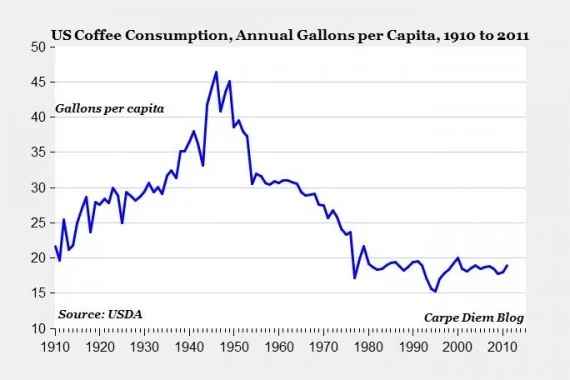
Here we can see that coffee consumption levels are actually lower as of 2010 than they have been since the beginning of the 20th century, with a emphasis on the drop we saw in the above graph that occurred in 1995 down to only 15 gallons per capita that year.
Since multiple graphs from different sources would suggest a certain trend, here is yet another graph, this time supplied by marketwatch.com.
You can see the same patterns echoed as with the previous graphs, showing the same trends in consumption (or lack thereof in recent years), except here in this graph you can see that this graph shows 1910 and 2010 as being more or less the same level of consumption (approximately 23 gallons of coffee per capita) whereas with the above graph there seems to be about a 5 gallon per capita discrepancy.
From this info, we can see that coffee consumption seems to be way down from what it used to be, but what does that mean exactly?
Does this mean that coffee is gradually losing popularity in the hot beverage business in the U.S. and it will fall out of favor with the public eventually? It can't be…can it?
A Closer Look At The Downward Trend
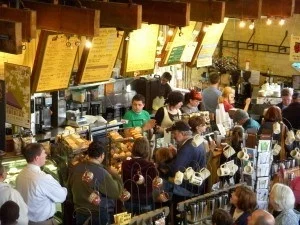
Initially, one might think that any "headline" proclaiming a downward trend lasting decades in American's overall coffee consumption would be cause for alarm both from coffee enthusiast and industry insider alike.
To coffee industry insiders, America's long, gradual decline in drinking less coffee over the years isn't exactly headline news. At the same time, this trend may not be what it seems at a glance.
As we've stated, other evidence points to an increased popularity with coffee in that there's now more shops than ever and people are spending more money on coffee than ever before. With some coffee shops being extremely busy morning noon and night, you'd never assume there was any downward trend in coffee sales. Here is a typical scene…
We think this so-called "downward trend" in coffee requires even more research to fully understand what it means, so lets dig a bit deeper.
More And More Starbucks's
If we operate under the assumption that America is "obsessed" with coffee, it might bring to one's mind the fact that Starbucks are continuing to expand through 2016 and predict more growth in the future with plans to launch a new expanded evening menu.
As it turns out, although Starbucks does have plans to keep growing (as we thought they might, since businesses that do not grow tend to stagnate and die), their plans include being open later and diversifying their menu to include more small plate food items, as well as wine and craft beer.
For now, here's a little review of a newer Starbucks beverage - the Starbucks Citrus Green Tea Frappuccino…
//knowyourgrinder.com/blg/kyg/user_img/20220207/1644547739373523.webp
According to statista.com and the graph we see above, there seems to be a clear trend towards coffee and snack shops overall earning more and more money each year in the United States.
Here we have a trend that reinforces the assumption that America is still very much interested in buying coffee, although factors which might affect that view include inflation, and also, particular questions like "What constitutes a coffee shop these days?", and "How much of this money is actually spent on coffee versus snacks or other beverages?"
Popularity Of Coffee Versus Other Beverages
According to an article in Forbes entitled "Younger Americans Are Ditching Coffee For Tea" (Niall McCarthy, February 2015), tea is setting the stage to compete for more and more of coffee's dollars in the coming years.
Of course, like coffee, tea has been much beloved for decades and has just as long of a history as coffee, if not longer. The website Bustle also has an article ("2015 National Coffee Drinking Trends Report Says Coffee Consumption In America Is Dropping - Are People Drinking Tea Instead?") which has the same gist as the Forbes piece, talking about some of the reasons that tea is coming on strong these days.
Your Average Human Bladder - Beverage Business Prime Real Estate
One thing to consider as well is that your average American only has room in their bladder for so much liquid, and to the beverage industry as a whole, that space is considered prime real estate.
People only get so thirsty, so with the proliferation of a growing number of beverages, of which tea is just one type, it makes sense that coffee is beginning to lose its grip as one of the few beverages that Americans consume.
In the 1940's, one can imagine the choices up for grabs were about 100 x less than today, so in a way its almost amazing that coffee has retained as much market share as it has, with the amount of fierce but delicious competition being offered today.
Soda Pop, Energy Drinks, and Other Beverages
We also can't discount soda pop as a major player in the battle for people's thirst.
Speaking of thirst, this brings up a fair point which is that while some drinks are designed specifically to quench thirst, as soda pop sometimes can, folks usually don't consumer coffee specifically as a thirst-quencher.
Tea is the same - unless maybe its iced tea, but regular tea is also not made to drink after you come back from a run.
Soda pop, with its very particular but growing niche in the beverage market, is definitely aiming to take a substantial piece of coffee's pie. In fact, it already has.
In the article "America's Coffee Cup Is Half Full" (February 2013), they remind us of the tale where in 1956, the chairman of the National Coffee Association, Arthur Ransohoff, ignored the threat of Coca-Cola, playing it down by banking on the evergreen nature of coffee's popularity.
Meanwhile, Coke was hiring movie stars to extol their virtues and getting their marketing machine in gear. They were new, fresh, exciting!
The result was that while Coke started to catch on with the kids who adored these stars, coffee began to languor. Was this a kind of comeuppance for coffee?
Global Popularity Of Coffee In 2016
So, we were wondering - is the United States more obsessed with coffee than other countries on a per capita consumption basis?
It would appear that the United States, as of 2014, wasn't even in the top ten nations who drank the most coffee per capita. Come again?
Yes, according to the The Atlantic's 2014 article which breaks down which countries consume the most coffee, the distinct honor of highest per capita coffee consumption would go to the coffee fiends / lovers in the Netherlands, drinking around 2.4 cups per day.
If you think about it, that means that every man, woman, and child in the Netherlands must be drinking coffee almost faster than it can be brewed!
Their dedication to the dark black stuff is certainly admirable, and this per capita coffee consumption makes America's coffee "obsession" seem more like a mild flirtation.
Heck, even Canada, locked in their frozen tundra wasteland to the north, still manages to snow-shoe out to the coffee shops more often than Americans per capita!
Single-Serve "Revolution" Having Its Affect On Per Capita Coffee Intake
Something else to consider, which the Reuters article also mentions, is that even though we are perhaps consuming less coffee per capita here in the United States, there is also a trend which shows we are actually spending more on the coffee overall. Ok, so we're spending more on coffee…but we're drinking overall less coffee…how does this work?
One of the things Americans are spending their hard-earned dollars on at the moment are those eco-unfriendly single-serve K Cup coffee pods, which Reuters refers to as a "revolution" in the coffee industry, although they are quite the eco-unfriendly little items.
Entrepreneur.com has an article which also talks about the K Cup, and how even its inventor John Sylvan has regrets about bringing these wasteful products into the world. At the same time as they are more wasteful, they are more convenient and less wasteful in that you aren't brewing a whole pot of coffee only to throw out half of it. Such a paradox. In any case, they will probably eventually merge with the Great Pacific Garbage Patch at some point. Want to feel bad for a few minutes? Watch this…
We Waste Less Coffee Today Than We Did In The 1940's
In 2016, as far as American coffee habits go, it would indeed be fair to say that single-serve coffee pods have become revolutionary, as single-serve pods like those by Keurig have already changed the way in which we consume coffee, and they can readily be pointed to as part of the reason that we are drinking less coffee overall today.
Back in 2013, David Sachs, Green Mountain's vice president for brand management, stated that 12 million out of the 118 million homes in America had Keurig machines and that amount was expected to triple by 2016, which is just around the corner.
If that projection was anywhere near accurate, this could actually mean that coffee will once again be on the rise, but in the form of smaller portions which may actually keep the overall U.S. consumption of coffee from skyrocketing.
As part of that increasingly popular K Cup single-serve trend, Reuters goes on to say that one of the main consumers of coffee, AKA your kitchen's drainage system, is now left completely out of the coffee-drinking equation since people are now looking to brew much more specific amounts of coffee.
Increased Home Brewing Skills Leading To Less Waste?
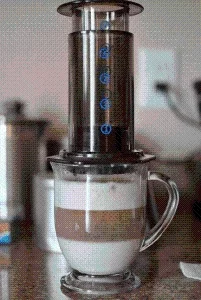
Rather than brewing a pot, drinking a cup or two, and dumping the rest down the drain, now there are so many ways to make more specific amounts of coffee (with the K Cup being one of the simpler but more eco-unfriendly ways), we've actually gotten less wasteful with our coffee in some ways.
Americans have had 60 years to learn the ins and outs of home brewing, developing coffee technologies and techniques that allow us to actually just buy what we need, such as Aeropress machines, and single cup brewing machines to name but two.
Of course, this isn't the entire story, but its a piece of the puzzle, and it is a factor in our overall consumption of coffee per capita.
Back in the 1940's, there were also far fewer options when it came to brewing coffee.
Nowadays, we have our espressos, our americanos, our cappuccinos, our lattes, etc.
Back in the 1940's there was just one option: coffee.
This may sound like your old granddad talking here, but more or less, this was the way it was (and we liked it). In fact, things were more or less just like this back in the old days…
See? No exaggeration there. And it was the same with coffee. You simply brewed a pot of coffee, and if you couldn't drink it all, you got rid of the rest. Down the drain it went where subterranean dwellers with no eyes collected it in buckets and carried it away to their lairs. That's just how it was.
So the question then becomes: How much of our nation's current coffee consumption can be attributed to less wasteful (or sometimes "differently wasteful") coffee technologies such as our Keurigs and our Aeropresses?
In November 2009 a special report was made by CHC ( Coffee Holding Co.), a leading wholesale coffee roaster and dealer in the U.S., which was discussed what was going on in the hot beverage industry in terms of sales and trends at the time, featuring both national trends and looking at growth potential within their own company.
One highlight of this report was the information shown in the graph below, showing the 19% combined U.S. and Canadian coffee consumption increase between 1998 and 2008.
This graph is another example of a graph that shows coffee consumption on the rise, as opposed to the fall. The entirety of the report can be found on this specific webpage at sec.gov.
Coffee Trends In America & Around The World - Assessment, Prediction & Conclusion
Two things seem clear here.
1. Coffee's popularity on the whole seems a bit overblown in North America.
Where does this misguided impression come from in the first place? Well, quite possibly coffee companies themselves who would like us to think that coffee is far more popular than it ever was, or maybe a sense of national pride in being the most coffee-guzzling nation under the sun. Also, some people just make a lot of assumptions.
2. Although coffee is still insanely popular with some folks, its popularity has definitely tempered over the years. We won't say it has slowed down (even though it has), because that will just make coffee drinkers angrier than they already are when they're raging on a caffeine high, 4 cups into a 10 cup binge.
And yet, that same popularity, while it has diminished in the ever-diversifying world of hot (and cold) beverages, cannot be underestimated or really thought to be "on its way out".
Still, with commercials like this one promoting a non-coffee beverage that shall remain nameless (actually, its just those hippies over at Frutopia), its clear that somebody (not saying who) out there wants a piece of the pie that coffee had nearly to itself over a half century ago.
Furthermore, there seems to be a trend toward increased specialization and diversification in the coffee market, both in terms of coffee as a beverage, and the machines and devices we use to make it, which is another reason the numbers are dropping. Indeed, here on this website we talk about the some of those very machines that have lead to such a diversity - coffee grinders, among other things.
To wrap things up here, if we had to make some sort of prediction or guess as to coffee's future, we don't see its per capita consumption rising to the level it was in the 1940's - that time is over - but we also think that the idea that coffee will slip out of popular favor seems rather unlikely any time soon.
Related Posts
 |
 |
 |
 |

About Jeanette Kierstead
Jeanette has been testing and reviewing kitchen appliances for over six years now, so she knows her stuff when it comes to finding the best ones. In her spare time, she loves nothing more than baking cakes and cookies – especially if she can do so with one of her favorite stand mixers! When she's not in the kitchen, Jeanette is usually looking after everything homes-related; from garden tools to smart home products.
Thoughts on "Coffee Consumption Trends Worldwide In 2016"
 |
 |
 |
 |
Get FREE Coffee Gifts now. Or latest free grinders from our best collections.
Disable Ad block to get all the secrets. Once done, hit any button below
 |
 |
 |
 |
